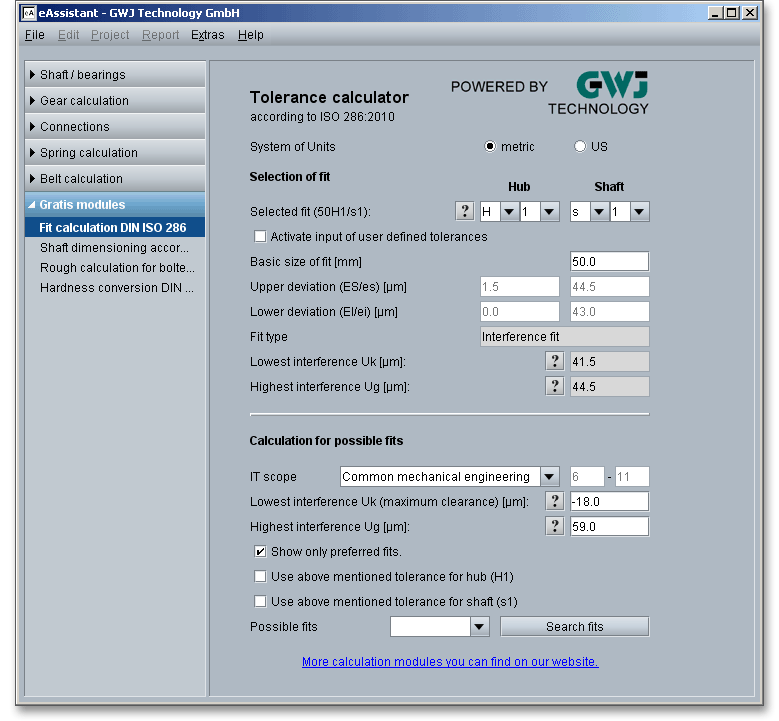
This calculation module enables you to determine the deviations of different tolerance fits for a given
nominal diameter very easily and fast. Here all IT classes and tolerance fields according to the
standard ISO 286 are available. The program determines only interferences or expects a user
input.
A clearance specifies a negative interference.

The upper part, the ‘selection of fits’, calculates the minimum and maximum interference by the determined deviations (UK = ei-ES and Ug = es-EI). Positive values indicate an interference, negative values indicate a
clearance. The upper part of the fit calculation allows you to select the tolerance field for the shaft and the hub very easily from the listbox. The fit calculator provides the tolerance system according to DIN ISO 286 including all IT classes. The upper part of the fit calculator allows to choose the tolerance field for the hub and the shaft.
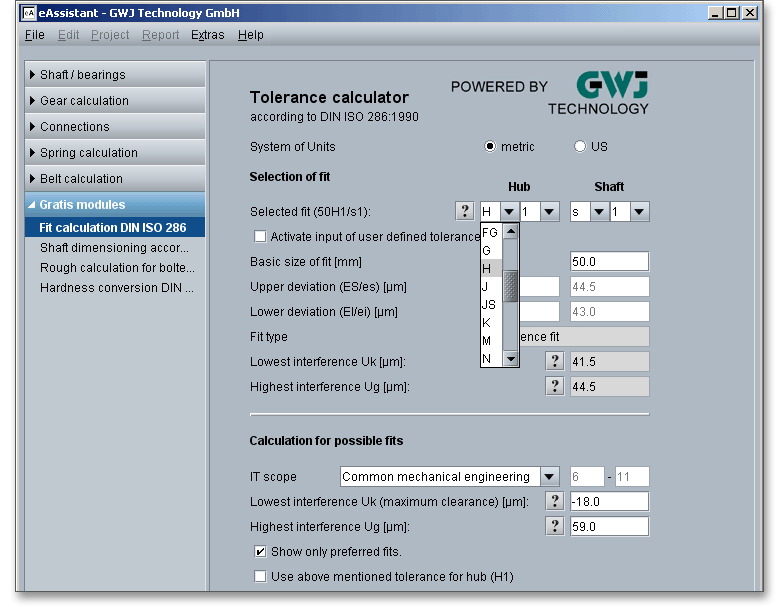
The program determines the lowest and highest interference or the clearance of the selected fit. Thereby, the calculator displays the type of fit:
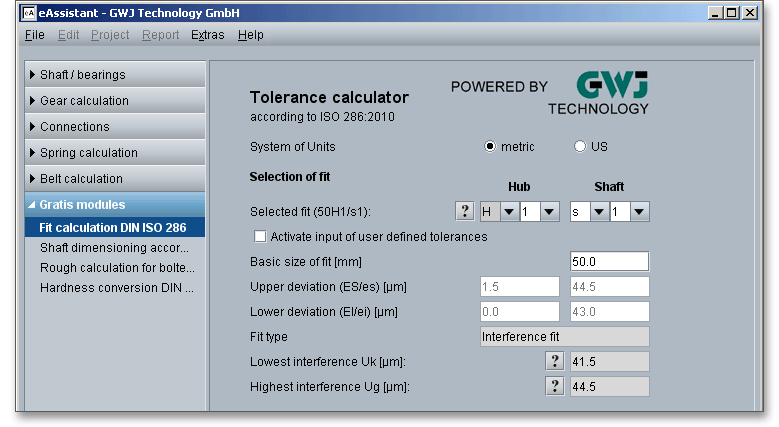
The deviations of shaft and hub can be entered manually. In order to do so, please enable the option ‘Activate the input of user defined tolerances’.
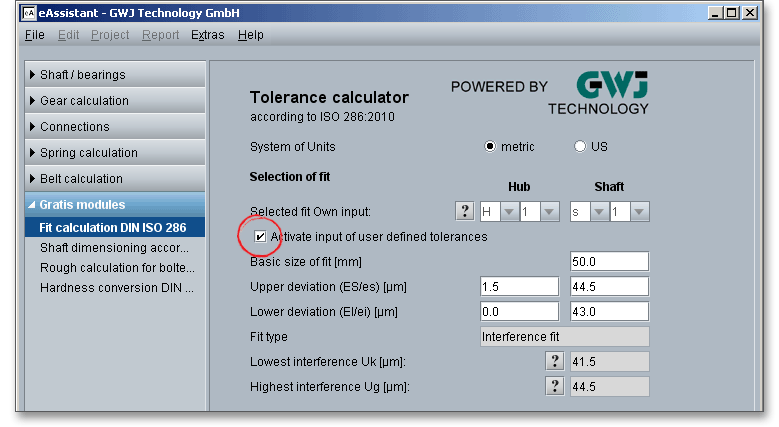
For the calculation of possible fits, the desired interferences must be entered by the user. The clearance is also
specified as a negative interference.
Examples:
Tolerance fits can be searched on the basis of default settings. For the dimensioning of a fit you have different
possiblities.
You can specify the lowest and highest interference for the calculation.
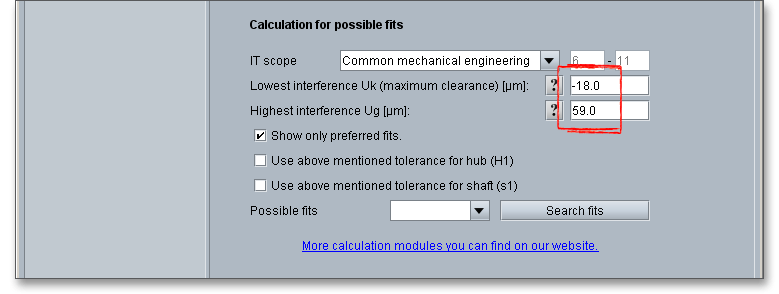
The button ‘Search fits’ shows you all possible fits.
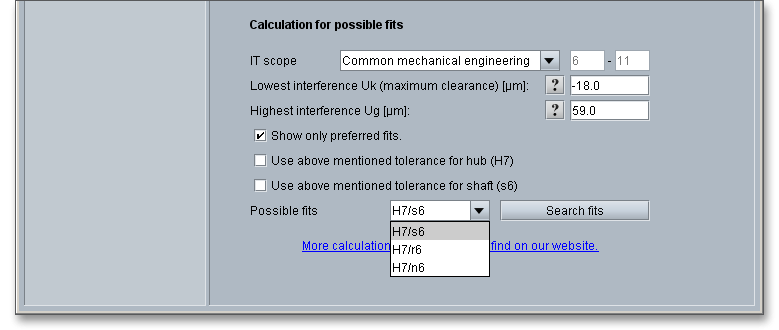
The option ‘Show only preferred fits’ is enabled by default. The list of fits is limited. Disable this
option and click the button ‘Search fits’. The number of fits increases. The message ‘More than 500
fits were found. Only preferred fits are shown’ may occur. If you confirm this message with ‘OK’,
the option ‘Show only preferred fits’ is automatically enabled. Then you can choose a fit from the
listbox.
Enable the following options and easily take over the tolerances from the upper fit calculation. Click the button ‘Search fits’ and the appropriate fits will be displayed.
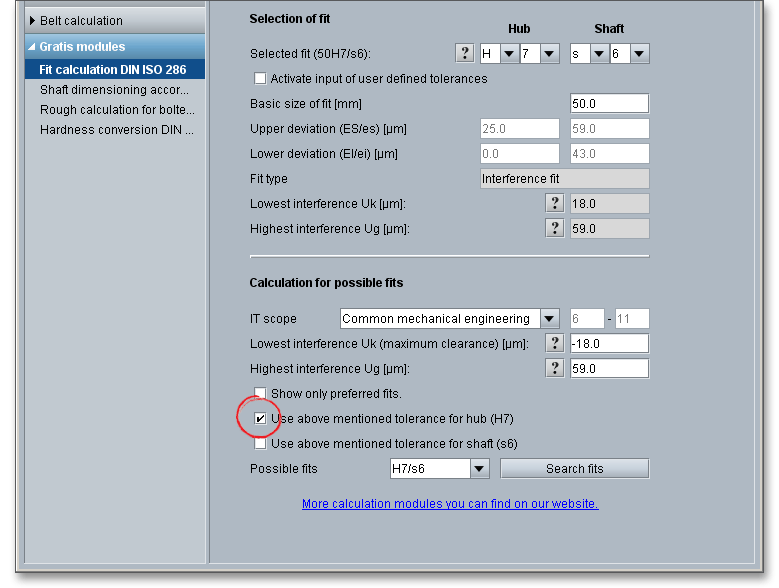
For the calculation of possible fits, the IT scope can be selected. The following IT scopes are available:
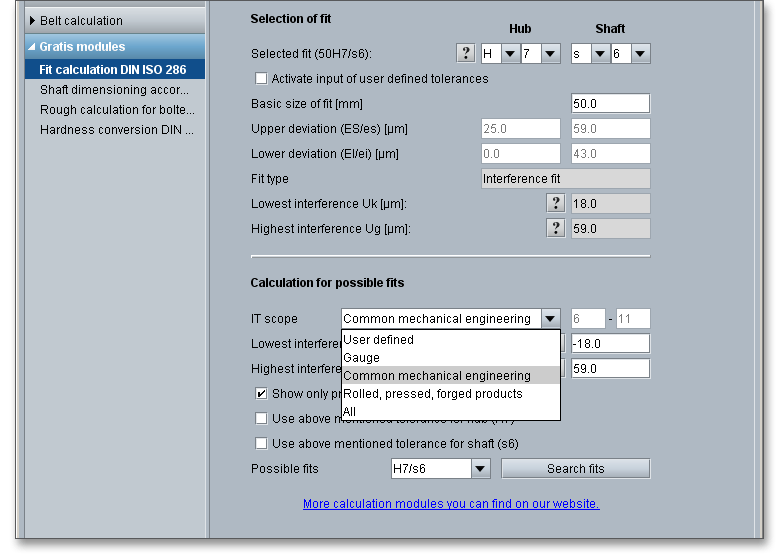
The following section gives some guidance on selecting fits according to E. & K. Felber. There are features that
can be expected in general during the assembly. The assembly rules specify the character of the fit and all
features correspond to the mean value of fits.
The list contains fits that are used frequently. Almost all fits can be formed in quality (e.g., from H8/f8 to H8/f7
to H6/f6). In general, the standard fits (e.g., H8/f7) can be used. According to the function, you
have to select fine qualities (e.g., H6/f6) for larger requirements (requirements for accuracy and
uniformity).
The following examples are taken from the mechanical engineering and cannot to be considered as complete in
any detail.
Interference Fit: H8/u8; U8/h7; H8/s7; S7/h6; H7/r6; R7/h6
Feature, Assembly: The parts are assembled and tightened and have a strong interference. The parts are
pressed together or assembled into position while hot and cooled. In general, a safety device against torsion or
shifting in lengthwise direction is not necessary.
Examples: Spur gears that are mounted tightly on a shaft, couplings, collar rings, press rings, wheel rims,
bearing bushings in housings, bushings in gear hubs, tight pivots, bushings made of synthetic resin pressed
material, parts which cannot be loosened by large forces.
Transition Fit: H7/n6; N7/h6
Feature, Assembly: The parts are mounted against each other. High pressure is necessary to join and
separate the parts. Due to clearance, the parts have to be secured against torsion.
Examples: Bearing bushings at machine tools, wheel rims on wheel bodies, levers and cranks on shafts,
impact-loaded parts, bushings in basic bodies, gears and couplings on shafts.
Transition Fit: H7/m6; M7/h6
Feature, Assembly: Parts sit tightly on top of each other. Joining and separating cases require large
expenditure of energy by using a hammer, parts have to be secured against torsion and shifting.
Examples: Pulleys, gears, bushings, lever on shafts, cranks for lower forces, piston pins in pistons, coupling
pins, fixing pins
Transition Fit: H7/k6; K7/h6
Feature, Assembly: Parts stick together and can be joined and separated by using some hammer blows
without enormous expenditure of energy. Parts have to be secured against torsion and shifting.
Examples: Coupling parts, pulleys, flywheels, handwheels, hand levers on shafts, gears on machine tool
spindles, bearing bushings in wheels and in basic bodies, fixing pins, pins, bolts, centralisations, coupling halves
and gears on shaft ends of electric motors over Ø 50 mm.
Transition Fit: H7/j6; J7/h6
Feature, Assembly: Easy to join by hammer blows, often movable by hand, not intended for functional shifting,
applicable for parts which have to be disassembled very often, a securing against torsion and shifting is possibly
necessary.
Examples Change gears, gears, pulleys, adjusting rings, bushings, bearing bushings and handwheels which
have to be removed very often, centralisations, coupling halves and gears on shaft ends on electric motors up to
Ø 50 mm.
Clearance Fit: H7/h6
Feature, Assembly: Parts can be moved manually by using lubricants. Still usable for a slow shifting.
Examples: Centralisations, change gears, adjusting rings, coupling parts wedged on shafts, tools on arbors
(e.g., milling cutters on milling-machine arbor), idler bushings, handwheels on spindles, spacer sleeves, sealing
rings, all kind of guides, tailstock sleeve, plain bearings with very small clearance, chain wheels, large
gears.
Clearance Fit: H8/h9
Feature, Assembly: Parts fit easily into each other and are easy to move.
Examples: Less important centralisations, adjusting rings, crank handles, gears, couplings, pulleys which have
to be moved over shafts, idler bushings, use of cold finished round steel (round steel, finish polishing made of
tool steel, cold work steel, high-speed steel).
Clearance Fit: H11/h9; H11/h11
Feature, Assembly: Parts can be easily stuck together. Clearance as low as possible with relatively large
manufacturing tolerances.
Examples: Less important centralisations, parts which are to be stuck together, soldered or welded, parts that
are pinned, bolted or clamped on shafts, spacer sleeves, hinge and snap pins, extensive use of cold drawn steel
bar (e.g., round steel, uncoated according to ISO tolerance field h9/h11).
Clearance Fit: H7/g6; G7/h6
Feature, Assembly: Parts are easily movable and twistable but without noticeable clearance.
Examples: Bearings for high requirements, change gears, movable coupling parts, indexing pin, valve lever,
cluster gears in gearboxes.
Clearance Fit: H7/h7
Feature, Assembly: Parts have noticeable clearance and are movable into each other.
Examples: Main bearing on machine tools, gear shafts, main bearing for shafts that run in two bearings, cardan
shafts, camshafts, crankshafts, bearing bushes, sleeves and floating sleeves on shafts, timing shafts, slide
blocks in guides, snap rings.
Clearance Fit: F8/h9
Feature, Assembly: Parts are movable, run easily and have large clearance.
Examples: Shafts with multi-bearing system, bearing shells, bearings where viscous lubricants have to be
used, bearings that are exposed to contamination (e.g., bearings on brackets), bearings of lead screws in slides,
chain sprockets run loosely, rope sheaves, axle boxes, use of cold drawn round steel, bearing of shafts of
dynamos, fans, centrifugal pumps.
Clearance Fit: H8/e9; E8/h9
Feature, Assembly: Parts are movable into each other and have a small to large clearance.
Examples: Main bearings for crankshafts, guide crossheads, guide for piston rods, pistons in cylinder, bearings
for gear wheel pumps, rope sheaves, bearings in internal combustion engines.
Clearance Fit: D10/h9
Feature, Assembly: Parts are very easily movable into each other and have a very large clearance.
Examples: Transmission shafts and countershafts, plain bearings for rough and adverse conditions, secondary
bearings for agricultural machinery, loose pulley, common bearings for locomotives, stuffing boxes,
bearings in centrifuges, axle boxes for conveyances, general centralisations, spindles for textile
machinery.
Clearance Fit: H11/d9, H11/d11; D11/h11
Feature, Assembly: Parts have large clearance and large manufacturing tolerances.
Examples: Guides and plain bearings of secondary importance, heat-treated plain gearings (e.g., by liquids and
gases), hinge pins and forked bolts, rivet pins, rivet joints, removable levers and cranks, socket wrenches, bad
lubrication of parts, shafts for turbogenerators and continuous-flow machines, high-speed spindles for textile
machinery, holes H11 (producible by using a twist drill that is guided in sleeves), use of cold finished round steel
h11.
Clearance Fit: C11/h11; H11/c11
Feature, Assembly: Parts with larger clearance and large manufacturing tolerances.
Examples: Secondary bearings for agricultural machinery and household appliances, pivot pins.
Clearance Fit: H11/a11; A11/h11; H12/b12; B12/h12; H11/b11; B11/h11
Feature, Assembly: Parts with very large clearance and large manufacturing tolerances.
Examples: Secondary bearings in locomotive and railway carriage construction, hinges, bearings for
agricultural and construction machinery, door hinges, pivot pins, bearings that are exposed outside to
elements.
Clicking the link ‘More calculation modules’ leads you to our web site. Here you can register for a free test account in order to use all eAssistant calculation modules (e.g., shafts, cylindrical gears, bevel gears, springs). Find more information in section 2 ‘Registration’).
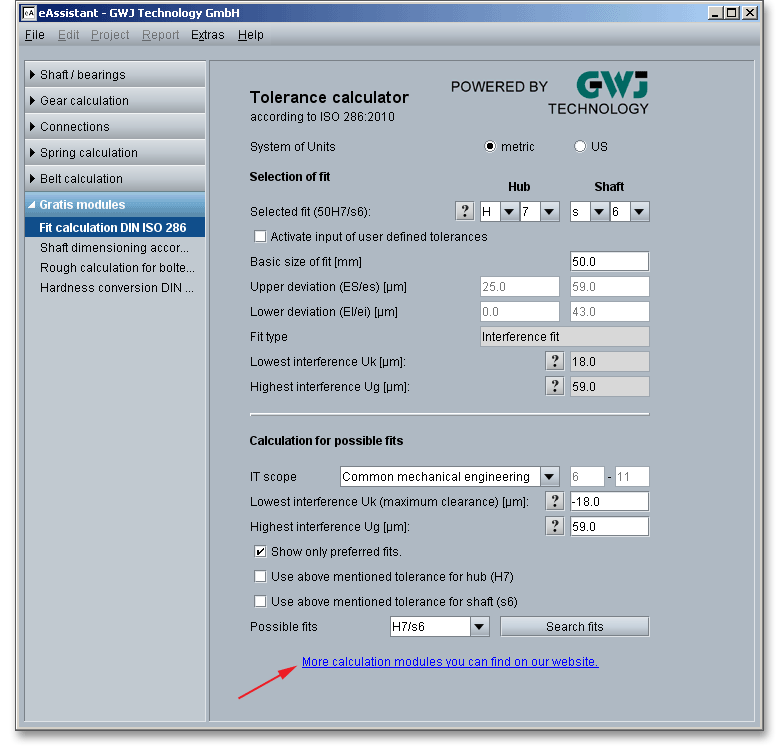
Please Note: If you registrate for the first time, you will receive a password in order to login. The project management helps you to start the calculation modules. The list on the left side shows all calculation modules including the free modules. If you use these modules, then no time will be deducted from your account.
Our manual is improved continually. Of course we are always interested in your opinion, so we would like to know what you think. We appreciate your feedback and we are looking for ideas, suggestions or criticism. If you have anything to say or if you have any questions, please let us know via telephone +49 (0) 531 129 399-0 or email www.eAssistant.eu.